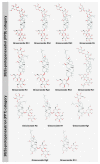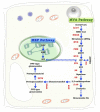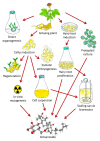Biotechnological Interventions for Ginsenosides Production
- PMID: 32252467
- PMCID: PMC7226488
- DOI: 10.3390/biom10040538
Biotechnological Interventions for Ginsenosides Production
Abstract
Ginsenosides are secondary metabolites that belong to the triterpenoid or saponin group. These occupy a unique place in the pharmaceutical sector, associated with the manufacturing of medicines and dietary supplements. These valuable secondary metabolites are predominantly used for the treatment of nervous and cardiac ailments. The conventional approaches for ginsenoside extraction are time-consuming and not feasible, and thus it has paved the way for the development of various biotechnological approaches, which would ameliorate the production and extraction process. This review delineates the biotechnological tools, such as conventional tissue culture, cell suspension culture, protoplast culture, polyploidy, in vitro mutagenesis, hairy root culture, that have been largely implemented for the enhanced production of ginsenosides. The use of bioreactors to scale up ginsenoside yield is also presented. The main aim of this review is to address the unexplored aspects and limitations of these biotechnological tools, so that a platform for the utilization of novel approaches can be established to further increase the production of ginsenosides in the near future.
Keywords: bioreactor; cell suspension; hairy root; polyploidy; protoplast.
Conflict of interest statement
The authors declare no conflict of interest.
Figures



References
-
- Sasidharan S., Jothy S.L., Vijayarathna S., Kavitha N., Oon C.E., Chen Y., Dharmaraj S., Lai N.S., Kanwar J.R. Conventional and non-conventional approach towards the extraction of bioorganic phase. In: Mohana Roopan S., Madhumitha G., editors. Bioorganic Phase in Natural Food: An Overview. Springer; Cham, Switzerland: 2018. pp. 41–57.
Publication types
MeSH terms
Substances
LinkOut - more resources
Full Text Sources
Other Literature Sources

